Excerpts from Jim Conrad's
Naturalist Newsletter
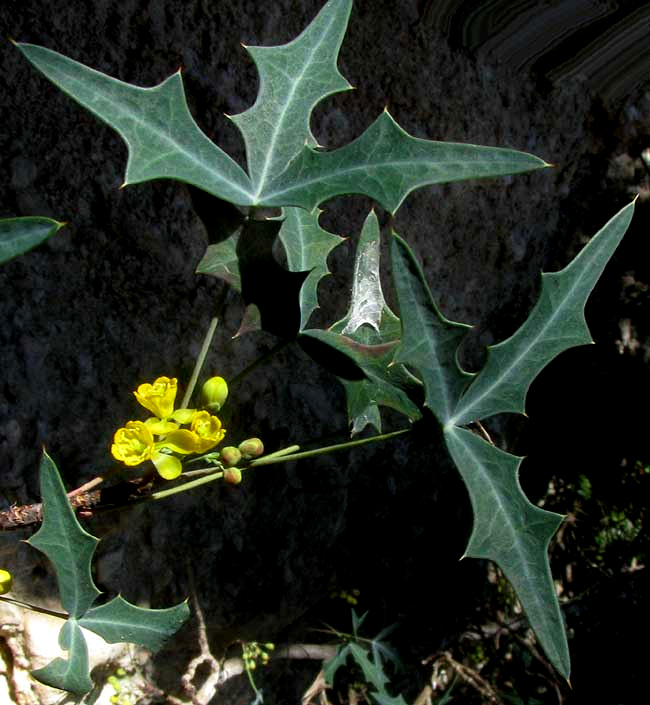
from the February 24, 2013 Newsletter issued from the valley of the Dry Frio River in northern Uvalde County, southwestern Texas, on the southern border of the Edwards Plateau; elevation ~1750m (~5750 ft); N29.62°, W99.86°; USA
AGARITA FLOWERING
A very common head-high, much branched, woody shrub in this area is one the ranchers don't like because its silvery-green, trifoliate leaves are so tough and spiny-margined that they can't be eaten by cattle -- even deer don't much care for them. Below you can see a typical one in a natural prairie opening in the woods, surrounded by Little Bluestem grass.
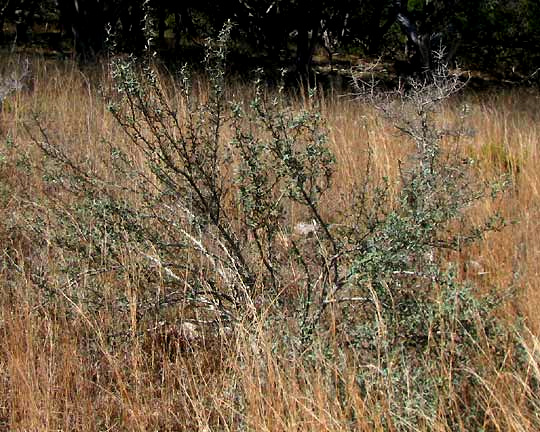
For about a month clusters of small, reddish flower buds have been enlarging along the woody stems, and this week some of the buds on plants in sheltered spots with a southern exposure released their flowers, as shown at the top of this page.
This is such a conspicuous shrub in our landscape that among English speakers it goes by several mostly Spanish names, including Agarita, Agarito, Algerita, Agritos, Currant-of-Texas, Wild Currant, and Chaparral Berry. It's BERBERIS TRIFOLIOLATA. The name Agarita surely is based on the Spanish verb agarrar, which means "to grab." The ending "-ita" is added to little things, to the Agarita "grabs a little," which might be said of a brush with scratchy but not very dangerous spines.
Agarita is a member of the Barberry Family, the Berberidaceae. In North America the Barberry Family is mostly known among wildflower admirers for its spring wildflowers, the May-Apple and Twinleaf, and among gardeners for such handsome ornamentals as the Nandina and barberries. Some authorities place Agarita in the genus Mahonia, but not the Flora of North America.
Walking down the road on a sunny day the sweet aroma of their half-inch-wide flowers is wonderful, like warm honey. Bees love them. The blossoms have six sepals and six petals, which is a little unusual for a dicot. Normally flowers with parts in multiples of three are monocots, such as the lilies and irises. However, the Barberry Family is a smallish one, so unusual flower features might be expected. You can see a freshly opened blossom with widely spreading sepals but with its corolla not yet fully expanded below:
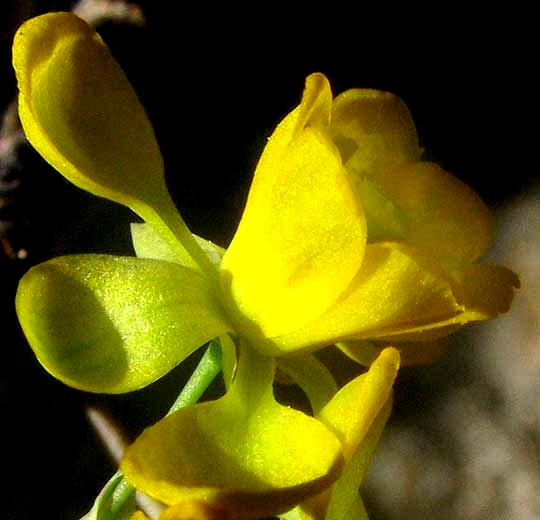
A view into a blossom showing more atypical features is shown below:
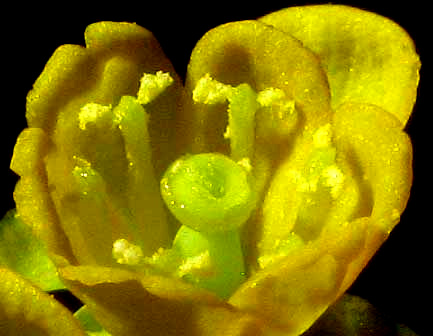
Few flowers possess such huge stigmas atop their ovaries -- stigmas being the female parts where pollen grains germinate. You can see that the ovary also is plumply oval. But what really is striking is how the six stamens are T-shaped, each arm of the Ts being one of the bags, or "valves," of the pollen-producing anther. You can see how yellow, sticky pollen adheres to the valves. Another unusual feature of anthers in the genus Berberis is that they are "irritable." When an insect leg or other object disturbs a ripe, unopened anther valve, the valve responds by releasing its pollen.
Agarita, like other barberry species, is susceptible to infection by Puccinia graminis, which is a fungus causing the Stem Rust disease of such agriculturally important Grass Family members as wheat, barley and triticale. A feature of the life cycle of Puccinia graminis is that it features "alternation of generations," which means that during part of its life it lives on grass species, and the other part on an entirely different species, in this case barberry plants such as Agarita. In some places where wheat, barley and triticale are grown people root out every barberry they can find, hoping to diminish their problems with Stem Rust. Here we're too arid for those crops so, fortunately for Agarita and us who are glad to have Agarita in the neighborhood, there is no such effort.
Agarita's red, pea-sized fruits are described as good tasting, though it's a pain to pick them through all those spiny leaves. Quail and other small mammals use the spiny plant for cover.
Agarita inhabits rocky, limestone soil in most of Texas, southern New Mexico, a tiny bit of Arizona, and much of arid northern Mexico.
from the May 11, 2014 Newsletter issued from the valley of the Dry Frio River in northern Uvalde County, southwestern Texas, on the southern border of the Edwards Plateau; elevation ~1750m (~5750 ft); N29.62°, W99.86°; USA
AGARITA FRUITS
Nowadays the Agarita's branches are loaded with pea-sized, succulent, red fruits, as shown below:
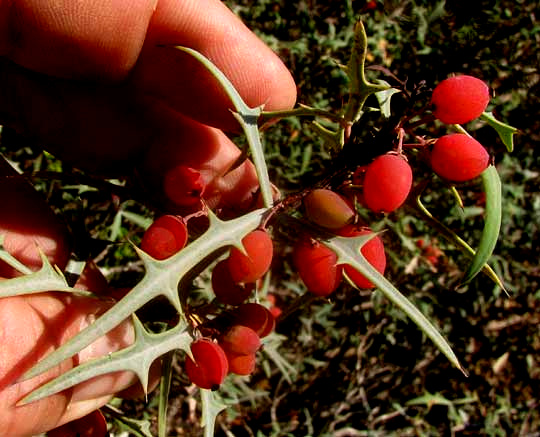
I've heard people claim that Agarita fruits are delicious and that sometimes jams are made of them, but I find them only slightly sweet or with any taste at all, though they are a little tart. Their seeds are small, however, so if you just want to nibble on them they're fine. I think that if people used to make jams of them, they were just looking for something to sweeten with sugar or honey, and as such they probably made fine jams.
But the thing about Agarita fruits is that when you collect them, the leaves' spines stick you. If you wear gloves, it's hard to grasp the fruits. Not many people nowadays are eating Agarita fruits.
from the September 29, 2013 Newsletter issued from the Frio Canyon Nature Education Center in the valley of the Dry Frio River in northern Uvalde County, southwestern Texas, on the southern border of the Edwards Plateau; elevation ~1750m (~5750 ft); N29.62°, W99.86°; USA
AGARITA'S YELLOW DYE
While digging a trench for some buried pipes I broke a bush's branch whose wood was bright yellow beneath dark brown bark. You can see it below:
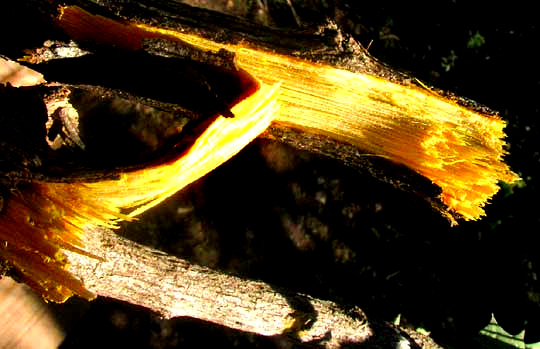
The bush was the Agarita, BERBERIS TRIFOLIOLATA, which is abundant here and easy to identify with its leathery, spiny-margined, evergreen leaves. When I whittled a handful of woodchips from the stem into a bowl of water, immediately the water yellowed, as shown below:
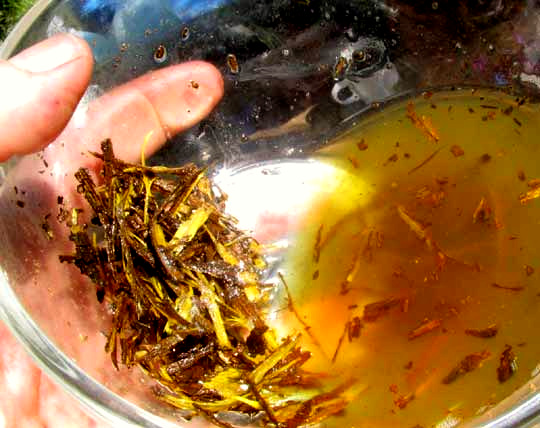
Sitting overnight, the yellowness didn't much intensify, so it seems that whatever causes the yellow color is highly soluble in water, and therefore probably it would tend to run if used as a dye.
Still, I read that the pioneers did use Agarita dye, and that during World War II dye from Agarita roots was used as one hue of color-coded parachutes. Parachutes for different drops were color-coded to indicate whether they contained equipment, supplies, food, or ammunition. Texas farmers contributed large amounts of Agarita roots.
The pioneers knew how to use "mordants" to make their homespun textiles retain natural dyes better. Mordants include tannic acid, alum, urine, chrome alum, sodium chloride, and certain salts of aluminum, chromium, copper, iron, iodine, potassium, sodium, and tin. Referring to her use of Texas Persimmon as a dye, Deb McClintock here in the Texas Hill Country writes, "Typically I use 12% alum sulfate to WOF (weight of fiber)."